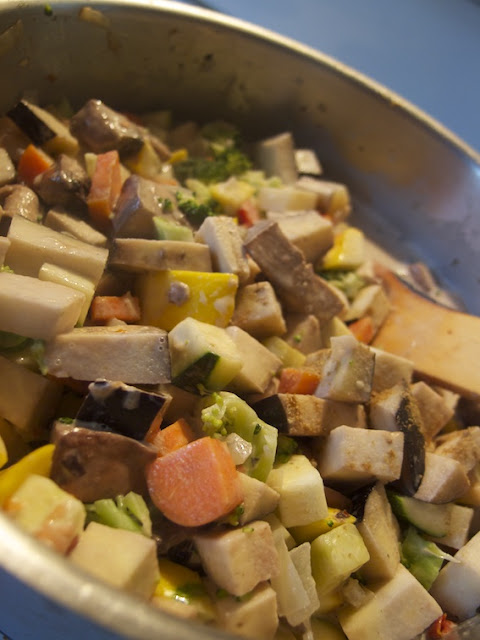This is a curry made completely from scratch using an assortment of aromatic spices.
Such things as herbs and spices, garlic and ginger, give dishes hearty, rich, flavours without using an overload of salt or salt-derived products (such as soy sauce, fish sauce etc etc.). Also, by making your meals from scratch, rather than using products and sauces found on supermarket shelves, you can control what you are consuming. A lot of people don't realise how heavily laden with salt, sugar and other crappy ingredients, these commercial products are. They also don't realise how gosh-darn simple it is to make their own!
The spice:
A few whole cloves
Half a dozen or so curry leaves
Mustard seeds
Chilli flakes
Cumin seeds
Caraway seeds
Ground cinnamon
NB: The seeded varieties of these spices are preferable, however if you only have the powdered varieties then by all means you can use those
1. Put all the spices together, liberally to your taste, on a baking tray. I like the flavour of the mustard seeds and chilli, so I tend to put more of those in.
2. Toast all spices naked and in a moderate oven until fragrant.
NB: Until your kitchen is filled with a delicious, succulent, aroma!
3. Grind the toasted seeds using a mortar and pestle until powdered. If you don't have a mortar and pestle, a strong sandwhich bag and meat hammer will suffice.
NB: Wack all the seeds in a mortar, and pestle the shit out of 'em!
The curry:
Garlic
Ginger
1 onion
400mL coconut milk
3tbs no-added salt tomato paste
Juice of 1 lime
1 large potato
2 cups lentils
1 tbs rice bran oil (or any other oil that has a high smoke point* and good mix of fatty acids)
A large amount of vegetables of your preference - squash, mushrooms, eggplant, zucchini, carrot, broccoli, spinach etc.
*The temperature at which the oil turns rancid - the chemical structure of the fatty acids is damaged and becomes oxidised (similar to trans fats). Obviously oils that can withstand higher temperatures are preferable when frying.
1. It's really quite simple - saute in oil the onion, garlic and ginger on low heat with the now ground, fragrant spices.
NB: If the heat is too high, the garlic, ginger and spices will burn, losing all of their flavour.
2. I like to add the finely diced potato now so it has the opportunity to absorb the flavour of the spices as well as fry off a little bit.
3. Pour in the coconut milk, lime juice and tomato paste, giving it all a good stir.
4. Add the vegetables. Leave the curry to simmer until the vegetables are 'el dente'.
On this particular occasion I used wild rice, which is not directly related to the Asian variety of rice most people think of. Alternatively, wild rice is an 'aquatic seed' native to North America. Wild rice takes a longer time to cook, but it is well worth the wait as you will get to see the grain split and curl up beguilingly.
I will also just make a further note about Asian rice - what is better for you. One cup of brown rice does have a higher GI* and energy content than the same amount of white rice. However, this is because it is whole - the grain is still intact and it has not been refined down to a mere shell. Brown rice has more carbohydrate, as well as a lot more vitamins and minerals. When I eat, I eat by the quality of the food, not by how many kilojoules I will have to work off. If you are worried about excess energy intake, then modify the size of the dish accordingly. For example have 1/2 cup of cooked brown rice instead of a cup of cooked white rice. And even if you do this, hunger should not be an issue, as brown rice is also a lot more filling.
It is important to also know that the GI of foods ranked high on the GI scale will be reduced if you eat it alongside food with lower GI. These foods are primarily made up of protein and (good) fats. So, therefore, eating the brown rice with the curry above (which contains protein and fats) will lower the GI of the meal.
*Glycemic Index. Wikipedia explains it nicely.













3 Researches REVEAL How Coconut Oil Kills Waist Fat.
This means that you actually get rid of fat by consuming Coconut Fats (including coconut milk, coconut cream and coconut oil).
These 3 researches from big medicinal magazines are sure to turn the conventional nutrition world upside down!